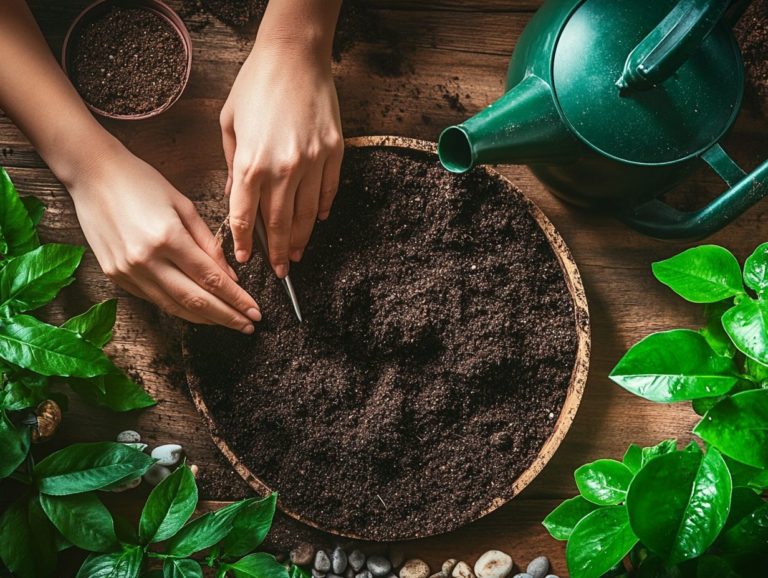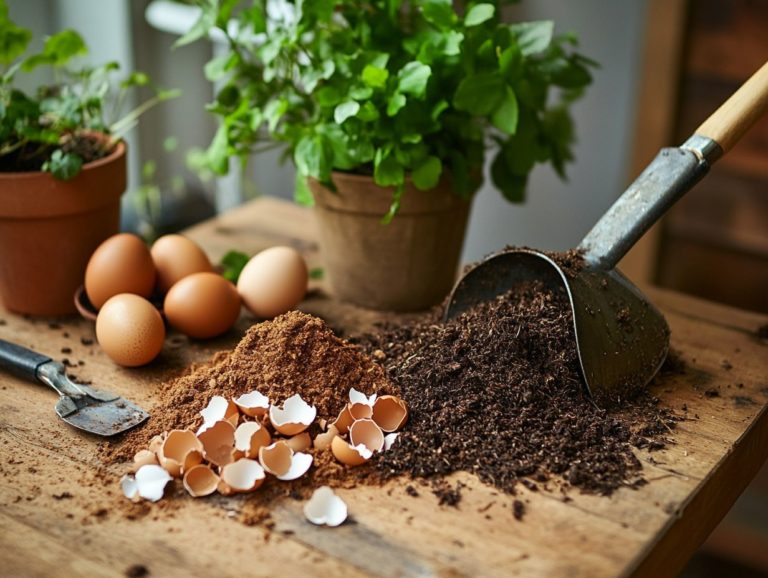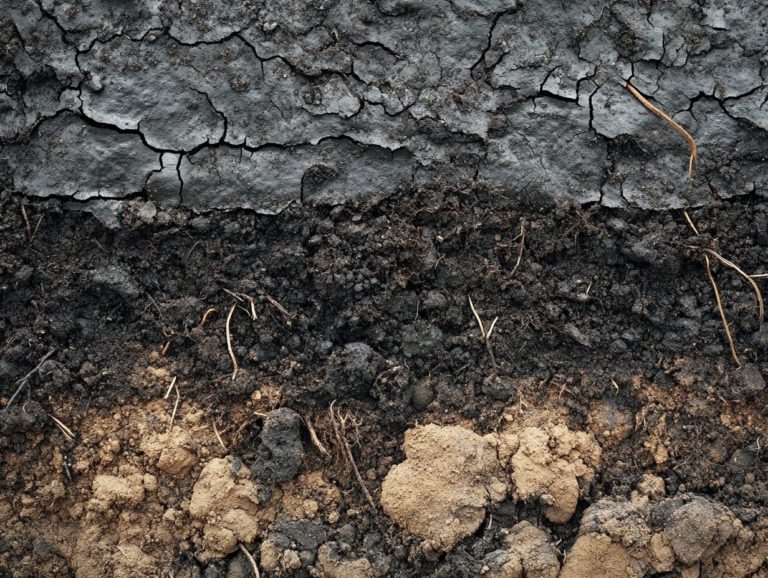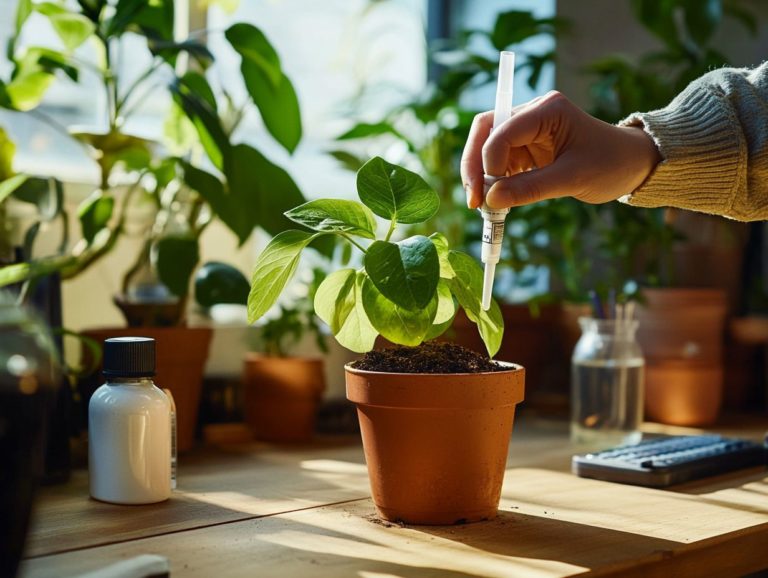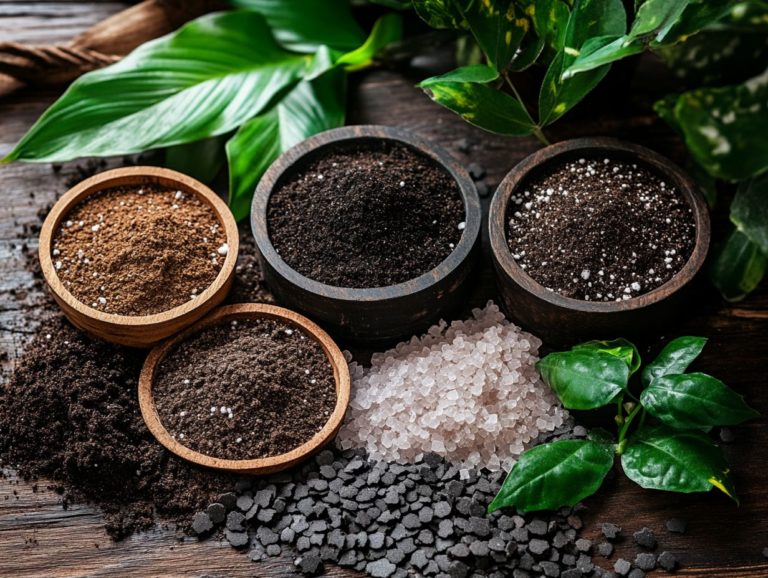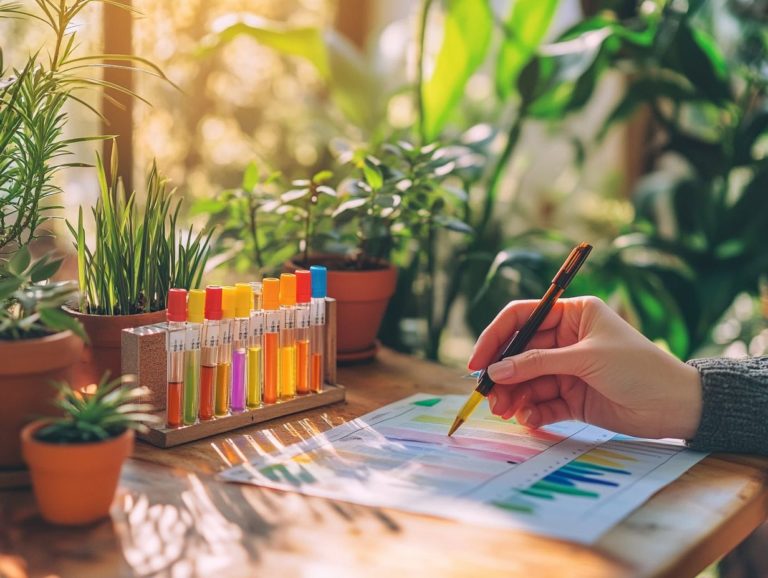Potting Soil vs Garden Soil: What’s Best?
Choosing the right soil is crucial for cultivating vibrant plants. Get ready to transform your gardening experience with the right soil choices, whether you’re nurturing a container garden or enhancing an outdoor space.
This article delves into the distinctions and commonalities between potting soil and garden soil. It provides clear guidance on their specific uses, benefits, and limitations.
We will also illuminate the best plants and conditions suited for each type. This knowledge empowers you to make informed decisions for your gardening pursuits.
Whether you’re a seasoned gardener or embarking on your green-thumb journey, valuable insights are just ahead!
Contents
- Key Takeaways:
- Overview of Potting Soil and Garden Soil
- Differences and Similarities
- Uses for Potting Soil
- Best Plants and Containers for Potting Soil
- Uses for Garden Soil
- Best Plants and Conditions for Garden Soil
- Pros and Cons of Potting Soil
- Pros and Cons of Garden Soil
- Which is Best for Your Garden?
- Frequently Asked Questions
- What is the difference between potting soil and garden soil?
- Can potting soil be used in the garden and vice versa?
- What are the benefits of using potting soil?
- What are the advantages of using garden soil?
- Can potting soil and garden soil be mixed together?
- Which type of soil is best for starting seeds?
Key Takeaways:
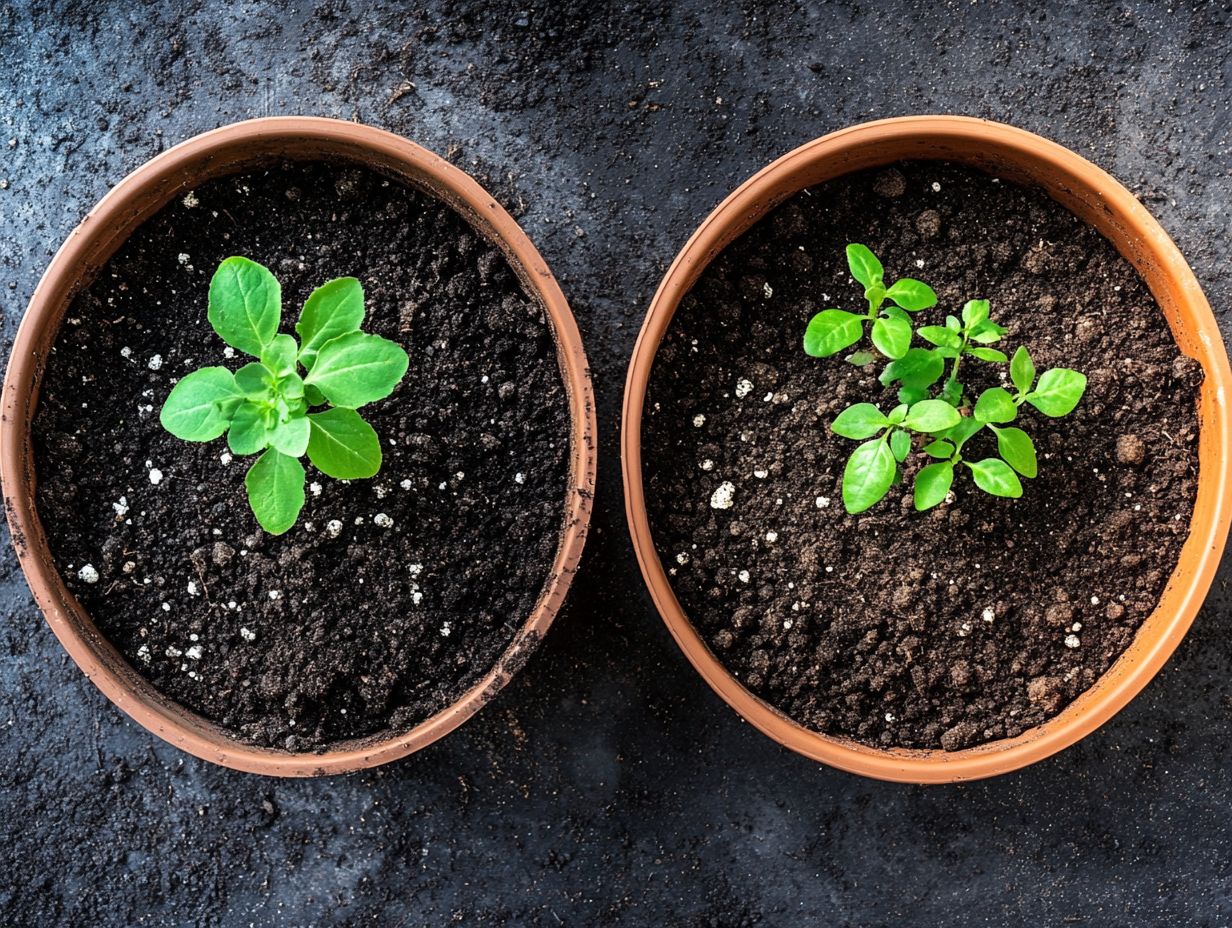
- Potting soil is ideal for container gardening and indoor plants, while garden soil is better suited for outdoor gardens and large plants in the ground.
- Potting soil is enriched with nutrients and designed to drain well, making it perfect for potted plants. Garden soil, on the other hand, may need additional amendments to provide enough nutrients for plants.
- When deciding between potting soil and garden soil, consider the type of plants you are growing, location, and specific needs of your garden. Both have their strengths and can be used together for optimal plant growth.
Overview of Potting Soil and Garden Soil
Potting soil and garden soil serve distinct purposes in the realm of plant care. Each is meticulously designed to cater to specific plant needs and growing conditions.
Garden soil provides a natural substrate, abundant in organic materials and essential nutrients. In contrast, potting soil is expertly formulated to create an ideal growing medium for container gardening.
Grasping the nuances of soil composition, including moisture retention and drainage capacity, is crucial for ensuring your plants thrive and flourish in their environment.
Differences and Similarities
Potting soil and garden soil may seem similar at first glance, but they differ significantly in composition, moisture retention, and intended uses. They share the common goal of nurturing plant growth.
Potting soil typically features a carefully crafted blend of materials like peat moss, perlite, and vermiculite. This combination ensures excellent air flow in the soil and drainage, making it a champion for container gardening. It prevents waterlogging while retaining just the right amount of moisture, making it perfect for your potted plants.
On the other hand, garden soil often incorporates native soil enriched with organic matter such as compost and decomposed leaves. This enhances fertility and structure. Despite their differing components, both potting soil and garden soil effectively promote soil health, creating an environment that supports a diverse range of plants, whether they’re cozy in pots or flourishing in open gardens.
Uses for Potting Soil
In container gardening, potting soil is critical. It offers a specialized medium designed to promote robust plant growth and facilitate successful seed starting.
It also creates a disease-free environment, ensuring that your plants thrive beautifully.
Best Plants and Containers for Potting Soil
When selecting the best plants for potting soil, it s crucial to consider specific varieties that excel in container gardening think seedlings, cacti, azaleas, and blueberries.
Each of these plants comes with its own set of requirements. For instance, cacti thrive in well-draining soil and appreciate the occasional dry spell, while azaleas prefer a more acidic environment to truly flourish.
The choice of container is equally important. Ceramic pots offer superior insulation and moisture retention, whereas plastic pots, while facilitating faster drainage, can inadvertently stress the roots if not monitored correctly.
Grasping the nutrient needs of these plants is essential. By ensuring balanced fertilization, you ll provide the vital minerals they need, promoting robust health and encouraging optimal growth in their container settings.
Uses for Garden Soil

Garden soil plays a critical role in nurturing healthy plants. It offers essential nutrients, organic matter, and a stable environment, all of which are crucial for robust plant growth and development within your garden ecosystem.
Dive deeper into our gardening tips and watch your plants flourish!
Best Plants and Conditions for Garden Soil
The best plants for your garden soil depend on the specific conditions you’re dealing with: sandy, clay, or loamy. Each type has unique benefits for different plant species.
Understanding these differences is crucial for growing a thriving landscape. For instance, sandy soils are famous for excellent drainage, making them ideal for drought-resistant plants like succulents and certain herbs.
In contrast, nutrient-rich clay soil is perfect for moisture-loving species such as ferns and various vegetables. Meanwhile, loamy soil, often considered the gold standard, provides a balanced environment for diverse plant life.
To ensure optimal growth, be mindful of soil properties. Making necessary amendments will improve fertility and health, creating sustainable conditions for your plants to thrive.
Pros and Cons of Potting Soil
Potting soil offers many advantages for container gardening, including improved soil aeration, exceptional moisture retention, and a blend of organic nutrients.
However, you should also recognize its limitations to ensure a rewarding and informed gardening experience.
Benefits and Limitations
The benefits of potting soil are impressive; it creates a lightweight, nutrient-rich environment that is perfect for your plants. Yet, it’s essential to be aware of limitations like water-holding capacity and potential nutrient leaching.
This specialized soil mix promotes root development with excellent aeration and caters to a variety of plant types, ensuring they receive the nutrients needed for vigorous growth.
Its formulation typically includes components designed to retain moisture without becoming overly saturated, crucial for maintaining healthy roots.
Keep in mind that some soil amendments can create complications. Regularly monitor moisture levels to avoid issues like root rot. Achieving a balanced growing environment depends on understanding both the strengths and weaknesses of potting soil.
Pros and Cons of Garden Soil
Garden soil is a versatile growing medium, offering benefits like rich nutrient availability and improved soil health.
Nevertheless, it has limitations such as potential for compaction and drainage challenges.
Benefits and Limitations
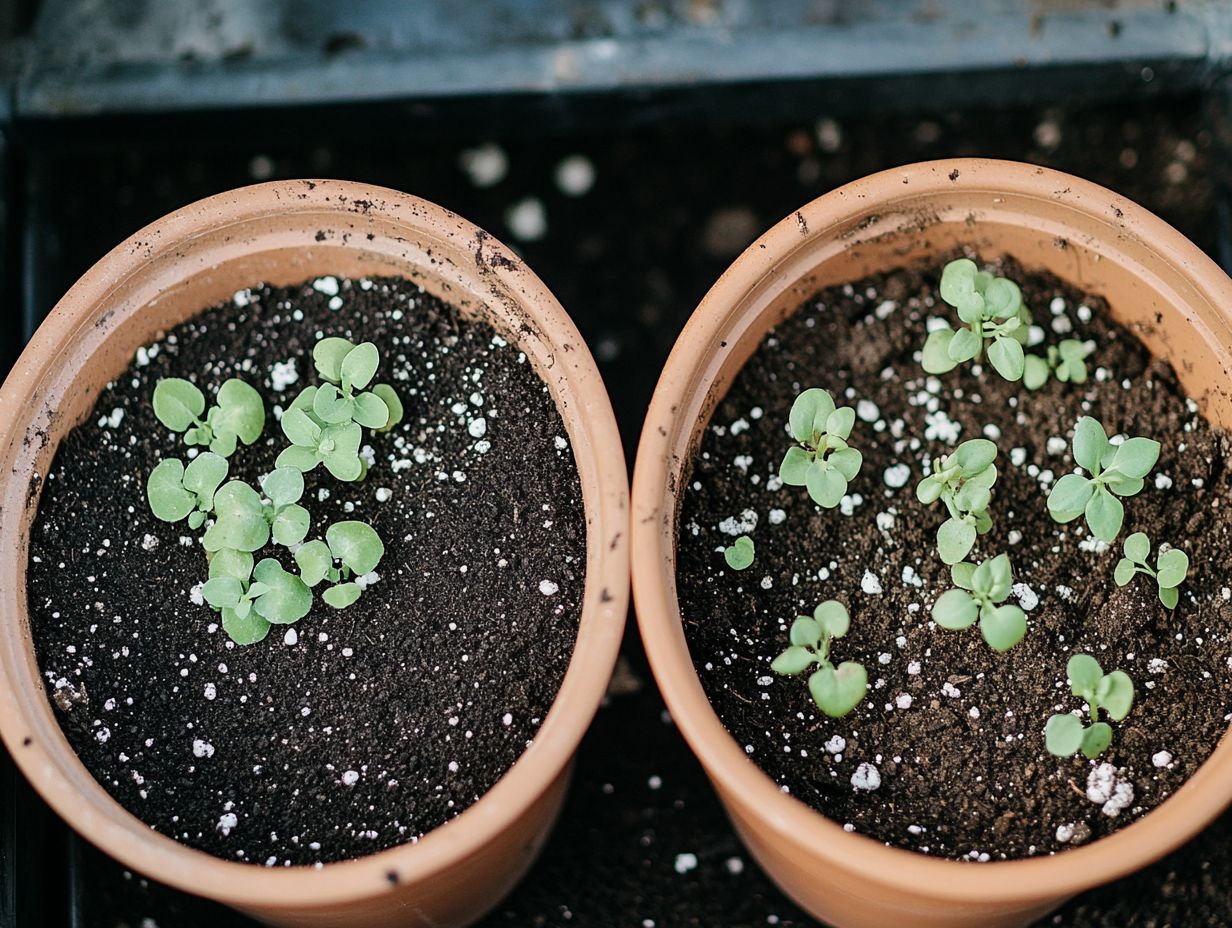
The advantages of garden soil lie in its rich diversity of organic matter and remarkable ability to enhance soil fertility. However, it’s important to consider potential limitations, like drainage issues that can affect plant health.
This dynamic fosters an ecosystem where essential nutrients are readily available to your plants, promoting their robust growth and vitality. Yet, certain soil types, especially clay soils, can significantly challenge root development.
As a gardener, grasping these dynamics is essential. You may need to add amendments like compost or sand to improve drainage and soil structure. This not only supports beneficial soil microbes but also creates an optimal environment for your plants to thrive.
Which is Best for Your Garden?
When choosing between potting soil and garden soil, consider several important factors. Reflect on your plants, the specific soil conditions in your garden, and your unique gardening goals.
Each choice has its implications, and thoughtful consideration will help you make the best decision for your garden’s success.
Get ready to enjoy a flourishing garden by experimenting with both soil types to find what works best for you!
Factors to Consider
When deciding whether to use potting soil or garden soil, you ll need to consider several factors, including the growth requirements of your plants, the conditions of your soil, and your specific gardening environment.
Your choice between these soil types will largely hinge on the variety of plants you intend to cultivate. Some species flourish in soils that allow water to flow through easily, while others thrive in denser soils. The available space whether it s a cozy balcony or a sprawling backyard will also significantly influence your gardening strategy.
Aligning your soil properties is crucial for vibrant plant growth! For instance, nutrient-rich potting mixes are often preferred for container gardening because of their lightweight nature and exceptional aeration.
Traditional gardening methods might benefit from improving the fertility of native garden soil, which can directly enhance plant health and yield.
Frequently Asked Questions
What is the difference between potting soil and garden soil?
Potting soil is specifically formulated for container gardening, while garden soil is meant for outdoor planting in the ground. Potting soil is lighter and more porous, allowing for better drainage and aeration, while garden soil is heavier and contains more organic matter to nourish plants.
Can potting soil be used in the garden and vice versa?
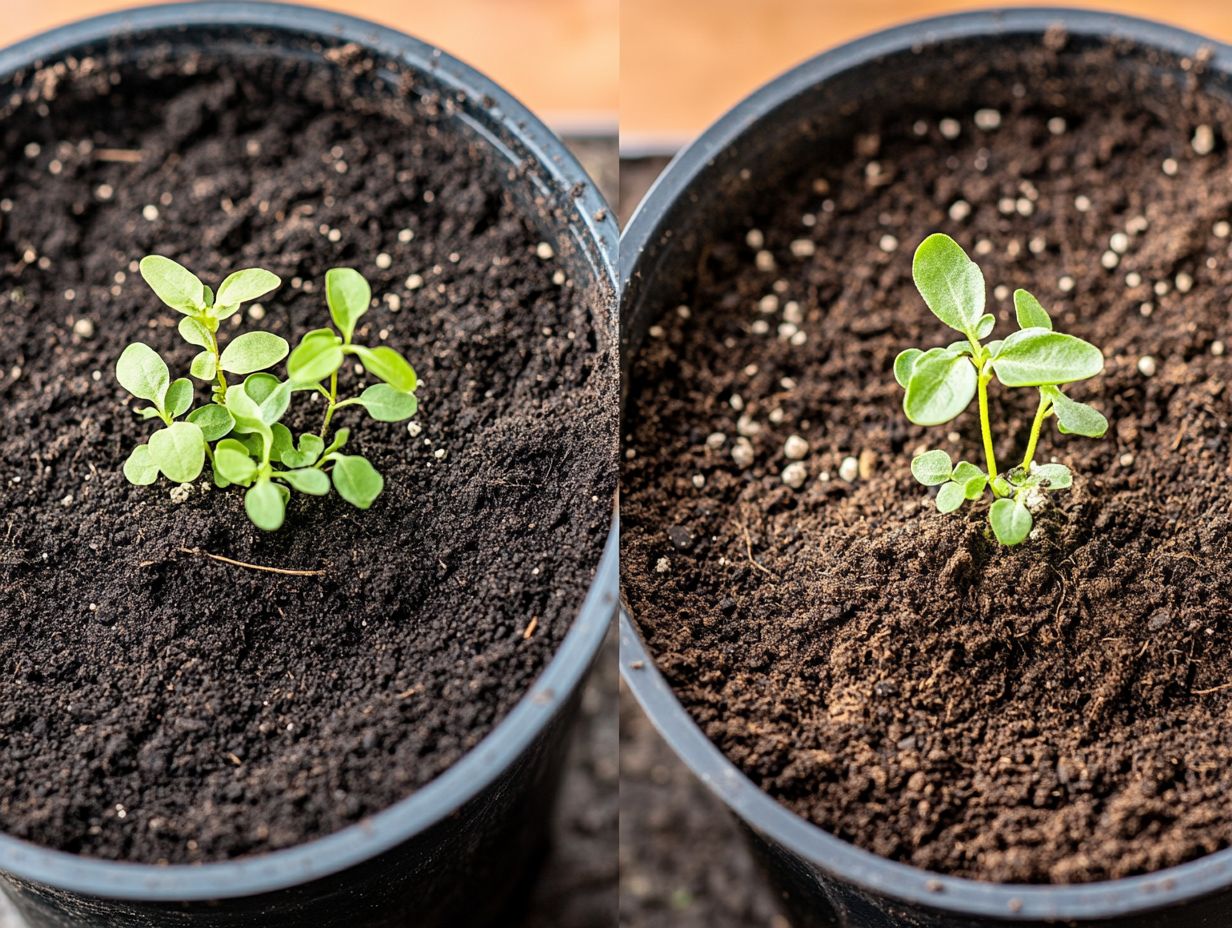
While it is possible to use potting soil in the garden, it is not recommended as it may not provide enough nutrients for the plants to thrive. Garden soil is not suitable for container gardening as it can become too compacted and retain too much moisture.
What are the benefits of using potting soil?
Potting soil is designed specifically for container gardening, providing the right balance of nutrients, drainage, and aeration to promote healthy plant growth. It also tends to be free of weeds and pests, making it easier to maintain a clean and healthy garden.
What are the advantages of using garden soil?
Garden soil is usually cheaper than potting soil and is readily available at most gardening stores. It contains a higher percentage of organic matter, which can improve soil structure and provide necessary nutrients for plants to grow strong and healthy.
Can potting soil and garden soil be mixed together?
Yes, mixing potting soil and garden soil can create a custom blend. This can be useful for certain plants that require specific soil conditions, but it’s important to ensure the ratio of potting soil to garden soil is appropriate for the needs of the plants.
Which type of soil is best for starting seeds?
Potting soil is generally recommended for starting seeds, as it is lighter and more porous, allowing for better drainage and root growth. Garden soil can be too heavy for delicate seedlings and may become compacted, hindering their growth.
Choosing the right soil is vital for your gardening success. Whether you opt for potting soil or garden soil, consider your plants’ needs, the space available, and your gardening goals. Happy gardening!

